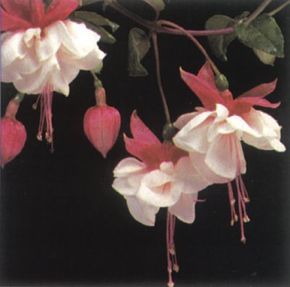
有数百名命名的紫红色品种,the beautiful plants with pendulous blossoms that bloom heavily from spring to fall. Most of them have been developed from two species. The name "lady's ear drops" is self-evident, but the name Fuchsia is more commonly used. The name honors Fuchs, a German botanist.
Description of fuchsia:Garden fuchsias are all more or less woody plants, some having a more erect, bushy habit; others with long, trailing stems from which blossoms hang. The flowers themselves are composed of a calyx, a brightly colored cylinder or tube that points downward, which is topped by flaring, petal-like lobes called sepals. The calyx can be single or double, and the sepals are either the same color or contrasting. The calyx and sepals may also be wavy and ruffled.
Advertisement
Growing fuchsia:Fuchsias bloom more freely when they get some shade. They're at their best in cool coastal or mountain regions with good humidity, but can be grown successfully in most places as long as they are kept moist. Fuchsias are heavy feeders. Apply a slow-release fertilizer at planting or feed biweekly with a water-soluble fertilizer. For large-blooming plants by mid-May, plant 3 to 5 rooted cuttings in a 10- to 12-inch basket. To develop full and shapely plants, pinch out tips as soon as two sets of leaves have formed and continue this process until March 1. Fuchsias are not winter-hardy except in Zones 9 and 10, but they can be stored over winter in temperatures above freezing but below 50 degrees Fahrenheit. Water only enough to keep the root ball from drying out. Light is unnecessary. In January, bring into the light, cut back plants by at least 50 percent, and resume normal watering.
Propagating fuchsia:By seed or by cuttings. Seeds germinate in 21 to 28 days.
Uses of fuchsia:Fuchsias are at their best in hanging baskets where the pendulous flowers can be viewed from below. They are most often placed where they can be seen frequently -- on decks, porches, or beside walkways. Upright varieties are eye-catching in containers raised on railings or porch steps. Fuchsias are also grown as standards or in tree form, with foliage and flowers flaring out from a single stem grown to the desired height.
Fuchsia related species:Fuchsia magellanica is a small-flowered, hardier species.
Fuchsia related varieties:Selections are so varied that it is best to choose them in bloom at a nursery or garden center. Swingtime, with double, white calyxes and red sepals, is by far the favorite variety. Double Indian Maid has blue-violet calyxes and red sepals. Lena bears double purple and white flowers. Jack Shahan is a single, pink flowered variety with a trailing form. Marinka, with a multitude of small, red, single flowers, has a counterpart, Golden Marinka, with variegated leaves. Gartenmeister Bonstedt is an old upright variety with numerous firecracker-shaped red flowers.
Scientific name of fuchsia:Fuchsia hybrida
Fuchsia can also be grown as a house plant. Learn more on the next page.
Want more gardening information? Try:
Advertisement



